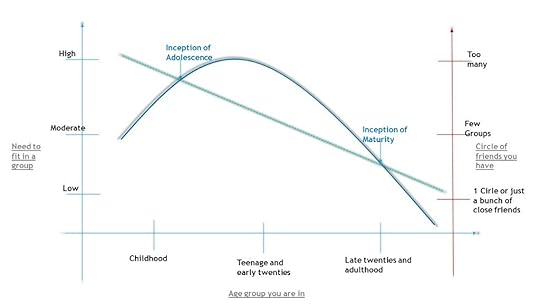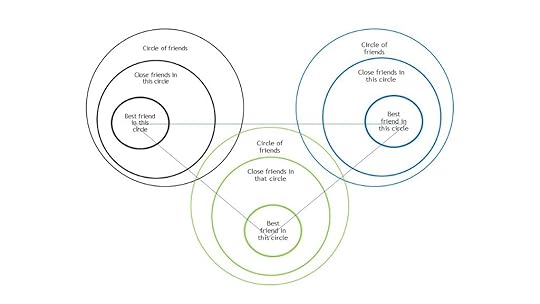Circles of friends — How we make them and lose them !
 Photo by Duy Pham on Unsplash
Photo by Duy Pham on UnsplashIt is said ‘ We cannot choose our siblings but we can choose our friends’. But does having a choice means that we do it right? We start making friends, the day we start making any verbal or non-verbal communication. Have you seen two babies play with each other?, they are already friends.
As toddlers, we take great effort to connect with everyone around us. Curiosity is at its peak and limited vocabulary not an obstacle. After spending our first two to three years in a protected environment and with familiar faces within the family, kindergarten is the first place which actually exposes us to the outside world for the first time. We watch a sea of kids like ourselves around us and instantly feel the need to know about each of them.Toddlers don’t have a personality. You can’t attach labels like studious, artistic, dumb, pompous etc to them, the way we attach to grownups. All toddlers in a kindergarten are like balls of clay or like a blank books, you can reach out to any of them without any preconceived notions.
As a little kid, you get attracted to anyone who has the same toys as you do, or enjoys the same games that you enjoy or even plays the same pranks that you do and in no time you start making friends. This process continues in primary and then in higher secondary school too. However, if I were to ask you to remember the day that a particular person qualified from being an acquaintance to a friend, you will not be able to. Pick any of your friends! Except for the ones who were introduced to you by common friends, you will not remember the day or moment with any other friend. That’s how seamlessly we make friends or a circle of friends. That’s how naturally they become a part of our lives.
Most of us have at least two circle of friends right since childhood. A circle of friends from the school and another from the locality we stay at. As we grow older we start becoming part of additional circle of friends . We have one from the coaching institute, then one from the karate class, then one from the school cricket team and so on and so forth. For kids who’s parents are in the government service or military and therefore have to change multiple schools, the multiplicity of friend circles is at a different level.
Till a certain point in childhood we don’t mind being part of any number of groups as long as the other members in the group don’t treat us badly.We assimilate without judgement. We go with the flow. As children we are honest. Often children say the most bitter truth to each other, have an ugly fight but still get along. That’s why we tend to have several circles of friends in childhood. It is more about the experience of being in the circle. However once the emotions of ego and jealousy take root in our minds, the dynamics change. Throughout this journey from childhood to teenage and early adulthood, all of us try to fit in with the groups that we are a part of, but how hard we try depends on what age group we are in.
It is in your teenage that friend circles really matter. It is almost as if your quality of life is directly proportional to your acceptability in the friend circles. Saying that ‘fitting in is a matter of life and death’ would not be an overstatement at this stage. What type of friend circle you would like to fit in really depends on your area of interest and acceptability in the group. Most of us want to be a part of the coolest group in college but we know that there are limited seats in the coolest group and so most of us end up with the second most preferred type of group. It could be the one with the most intelligent people or the one which bunks the class more often or maybe the one which seems to get the same percentage of marks that you do. Everyone’s priorities are different.
Curiously enough, I decided to plot a graph to depict the correlation of ‘the age group that you are in' with the following two things:
First — ‘our need to fit in the group' and
Second — ‘the no of groups we are a part of’.
See the graph below.

The X-axis is the ‘age group you are in’ and the Y-Axis on the left is 'the need to fit in the group' while the Y-Axis on the right is the ‘circle of friends you have’.
The curved line depicts the relation between ‘need to fit in the group’ with the ‘age group that you are in’. According to me the need to fit in the friend circle is moderate in childhood and grows gradually until it reaches its peak during teenage but as we reach our twenties this urge to fit in starts reducing until finally we reach a point where friend circles really don’t matter much.
The straight line growing from high to low depicts the relation between ‘ no of friend circles we have’ to the ‘age group we are in’. As can be seen from this plot, the number of friend circles in childhood tends to be the most and starts reducing gradually until we reach late twenties. What matters in your late twenties is those few friends who you genuinely like and who care for you and not the entire circle of friends. All other friends get reduced to acquaintances again. We get out of touch with a lot of people that we couldn’t live without in the past. Family also becomes a priority. The family that you took for granted during your growing up years is now suddenly at the forefront. Work takes over too. This is not to say that we no more have friend circles but they are much less. In our twenties we also understand our relationship/friendship mistakes of the past and some of us try to make amends too. It is a phase where we often retrospect and try to think of how we could have handled a particular friendship or relationship differently.
As you can also see in the graph, the straight line intercepts the curved line twice. I would like to call the first intersection on the left as the ‘inception of adolescence’. This the point from which our urge to fit in starts peaking while we become selective about becoming part of any friend circle. On the other hand the second intersection is called as the ‘inception of maturity’. The point at which we realize, it is not necessary to worry about every friend’s opinion. In fact it is the point where we decide that there is no need to have so many friends at all as long as we are good with our selected set of friends.
Needless to say this graph is an attempt to represent what most of us experience from childhood to adulthood and does not apply to every human being. There are always exceptions to the rule. Of course some know what they want right since childhood. Many achieve maturity at a very early stage while some don’t achieve it even in their late twenties. The graph is what majority of us experience.
But what happens once we reach our thirties. I would like to believe we continue to stay friends with few chosen ones and attach the friends tag to any new acquaintance after a lot of deliberation and thought. Both lines move more or less parallel to the X-Axis.
— — — — — — — — — — — — — — — — — — — — — — — — — — — — — — —
While I touched upon how our friend circles evolve there is one more aspect of friend circles that I want to bring to your notice. It is an aspect that we all know exists but sometimes like to believe that it doesn’t. See pic below.

Every friend circle has one or two more friend circles within it. There is one circle of friends who are closer than the rest and those who are the closest and can be called your best friends within that circle. Consider any of your friend circles. If there are 10 people in the friend circle, you will be more close to 2–3 among them. If it is a circle of five, there will be at least one that you prefer to hangout with more than others. In fact when this inner circle of friends doesn’t turn up while chilling out with the actual circle of friends, you will not have the same fun that you do otherwise. Also if you find out in advance that they are not going to show up for a particular weekend hangout, you will also make an excuse to not go. It is these inner circle of friends who more often than not remain your friends in the long run while the other start fading away with time.
What remains later are not circle of friends but a triangle of friends. Please see the triangle linking all the close friends in different circle of friends that we have been a part of throughout our life. We make an active attempt to stay in touch with only these few friends that lie at the vertices of this triangle. But then again, we don’t make just 3 circle of friends in our growing up years and therefore it doesn’t have to be a triangle of friends but can be quadrilateral, hexagon, cube or any other shape but not a circle. I am sure you get the drift.
So this was my attempt to elaborate how we make and lose our circle of friends. If you agree with my theory, let me know and even if you don’t I will be happy to know your take.




